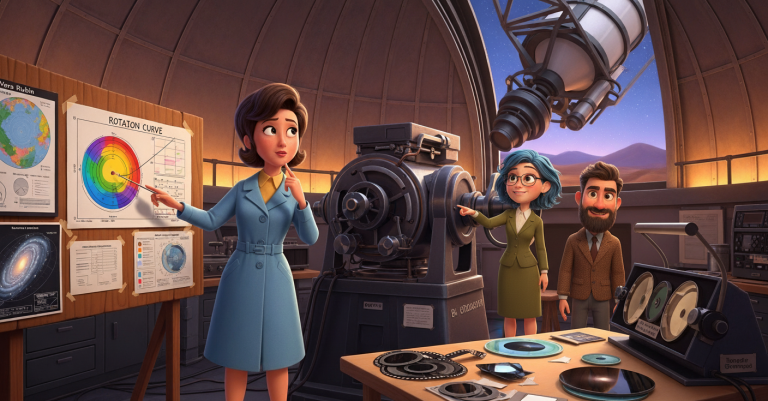Vera Rubin: The Star Detective Who Found the Universe’s Hidden Treasure
Imagine Looking Up at Night and Discovering a Secret
Picture this: You’re standing in the middle of a desert on a crystal-clear night. Above you, millions of stars twinkle like diamonds scattered across black velvet. You point a giant telescope at a spinning galaxy far, far away – so far that its light has been traveling for millions of years just to reach your eyes! Now imagine discovering that most of what’s out there is completely invisible. That’s exactly what happened to an amazing scientist named Vera Rubin, and her discovery changed everything we know about space!
Ben and Pia would love this story because it shows how one curious person with a telescope became a cosmic detective. Vera didn’t just look at pretty stars – she measured how fast they were spinning and found something that shouldn’t have been there. Something dark, mysterious, and absolutely enormous!
Meet Vera: The Girl Who Loved Star Maps
Vera Rubin was born in 1928 in Philadelphia. As a little girl, she would press her nose against her bedroom window and watch the stars move across the sky all night long. While other kids were playing with dolls or toy cars, Vera was making her own star maps and wondering why galaxies moved the way they did!
When she grew up, Vera wanted to study astronomy at Princeton University, which was one of the best schools for learning about space. But here’s something that sounds crazy today: Princeton wouldn’t let women study astronomy! Can you imagine? They said girls couldn’t understand stars and planets. How wrong they were!
Did You Know?
- Vera built her first telescope when she was just 14 years old!
- She once taped a simple paper sign reading “Women” on a men’s restroom door at a famous observatory
- She had four children and still managed to make groundbreaking discoveries about the universe
The Mystery of the Spinning Galaxies
In the 1960s, Vera teamed up with a brilliant instrument maker named Kent Ford. Together, they had a plan that would rock the scientific world. They wanted to measure exactly how fast different parts of galaxies were spinning. Think of a galaxy like a giant pinwheel made of billions of stars!
Scientists thought they knew what they’d find. Just like when you spin a basketball on your finger, the parts near the center should move fast, and the edges should move slowly. That’s what made sense. That’s what the math said should happen.
But Vera and Kent discovered something absolutely mind-blowing: the edges of galaxies were spinning just as fast as the centers! It was like discovering that the outside edge of a merry-go-round was moving at the same speed as the middle part. That should be impossible!
How Did They Measure Galaxy Speeds?
Here’s the cool part: Vera and Kent used something called the Doppler effect. You know how an ambulance siren sounds higher when it’s coming toward you and lower when it’s moving away? Light does the same thing! When stars move toward us, their light looks a tiny bit bluer. When they move away, their light looks a tiny bit redder. By measuring these tiny color changes, they could tell exactly how fast different parts of galaxies were spinning!
The Night That Changed Everything
Picture this scene: It’s a cold night in 1968 at Kitt Peak Observatory in Arizona. The dome of the 84-inch telescope slowly opens with a mechanical groan. Inside, Vera adjusts her instruments while Kent fine-tunes their special light-detecting device. They’re pointing the telescope at the Andromeda Galaxy – our closest big neighbor in space.
Hour after hour, they collect tiny specks of light that have traveled 2.5 million years to reach Earth. Each speck tells a story about how fast that part of the galaxy is moving. As dawn approaches, they have their answer – and it doesn’t make sense!
The outer edges of Andromeda were moving way too fast. If the galaxy only contained the stars they could see, those outer parts should have been flung into space long ago. But there they were, held in place by… what?
Life Back Then
In the 1960s, computers were enormous machines that filled entire rooms and were much less powerful than your phone today! Vera had to do most of her calculations by hand, checking every number carefully. She would spend days at observatories in the desert, sleeping just a few hours before dawn, then returning home to cook breakfast for her four children!
The Invisible Universe Reveals Itself
At first, Vera thought they’d made a mistake. She checked their instruments again and again. They tested other galaxies. The same impossible pattern appeared everywhere they looked! Finally, there was only one explanation that made sense: there had to be much more matter in galaxies than anyone could see.
This invisible stuff became known as dark matter. It doesn’t shine like stars. It doesn’t glow like gas clouds. You can’t see it with any telescope. But its gravity was definitely there, holding galaxies together like invisible glue!
Think about it this way: imagine trying to understand a busy playground by only watching the shadows on the ground. You’d see shadow-kids running around, but you wouldn’t know what was casting the shadows. That’s what astronomers had been doing with the universe – only seeing the bright parts while missing most of what was really there!
Fun Fact: How Much Dark Matter Is Out There?
- Dark matter makes up about 27% of the entire universe!
- Regular matter (stars, planets, people) is only about 5% of everything
- That means the universe is mostly made of stuff we can’t even see!
- Every galaxy sits inside a huge, invisible “halo” of dark matter
Standing Up for Science and Equality
Vera didn’t just discover dark matter – she also fought to make sure all scientists could do their best work, no matter who they were. When she visited the famous Palomar Observatory in California, she found that there were no bathrooms for women because so few female astronomers worked there. Instead of complaining, she simply taped a piece of paper that said “Women” on one of the doors and got back to work!
She believed that science belonged to everyone willing to work hard and ask good questions. Throughout her career, she made sure her assistants and students got proper credit for their work. She spoke gently but firmly when people tried to dismiss women in science.
Breaking Down Barriers
Vera was elected to the National Academy of Sciences in 1981 and received the National Medal of Science in 1993 – two of the highest honors a scientist can receive. But she always said her greatest pride came from the young scientists she helped along the way, especially women who might not have continued in astronomy without her encouragement.
The Hunt for Dark Matter Today
Vera’s discovery started one of the biggest treasure hunts in science! Today, thousands of scientists around the world are trying to figure out what dark matter actually is. They’ve built incredible underground detectors, launched space telescopes, and created computer simulations of the entire universe.
We now know that dark matter helped shape everything we see. Without it, galaxies wouldn’t have formed. Stars wouldn’t have been born. Planets like Earth might never have existed. The invisible universe isn’t just mysterious – it’s essential for life itself!
Modern Dark Matter Detectives
- Scientists have built detectors deep underground to catch dark matter particles
- The Hubble Space Telescope can see dark matter’s effects by watching how it bends light
- Supercomputers run simulations with trillions of dark matter particles
- New space telescopes are being built to study dark matter across the cosmos
The Vera Rubin Observatory: A Telescope Named After a Hero
In 2020, scientists named a amazing new telescope after Vera. The Vera C. Rubin Observatory sits on a mountaintop in Chile and has a mirror as wide as a tennis court! Every few nights, it takes a picture of the entire visible sky. Over ten years, it will create the most detailed movie of the universe ever made.
This telescope will spot millions of asteroids, discover exploding stars, and trace dark matter across billions of light-years. It’s like giving scientists a time machine to watch how galaxies grow and change. And it all started because one curious woman noticed that galaxies weren’t spinning the way they should!
What Makes the Rubin Observatory Special?
The telescope’s camera is the largest digital camera ever built – it’s as big as a small car and can take pictures with 3.2 billion pixels! That’s about 1,500 times more detailed than the camera on your phone. Every night, it will collect enough data to fill about 1,000 smartphones!
Lessons from the Stars
Vera Rubin’s story teaches us so many important things. First, the biggest discoveries often come from noticing small details that everyone else missed. Vera succeeded because she was incredibly careful and patient. She checked her work over and over again. She didn’t rush to announce her findings until she was absolutely sure.
Second, science works best when different people work together. Vera needed Kent’s amazing instruments. She needed help from other astronomers and students. She needed telescopes that other people built and maintained. Great discoveries are team efforts!
Most importantly, Vera showed that being different can be a superpower. Because she faced challenges that men didn’t face, she developed qualities like persistence and attention to detail that made her an exceptional scientist.
The Mystery Continues
Even today, we still don’t know exactly what dark matter is made of! Scientists have lots of ideas – maybe it’s made of particles that barely interact with regular matter, or maybe it’s something even stranger that we haven’t imagined yet. The mystery that Vera uncovered is still waiting to be completely solved!
Dark Matter Is All Around Us
Here’s something incredible to think about: dark matter is everywhere, including right where you’re sitting! At this very moment, billions of dark matter particles are probably passing through your body every second. You can’t feel them because they barely interact with regular matter at all. It’s like you’re sitting in an invisible river that flows through everything!
Our entire solar system is traveling through a cloud of dark matter as it orbits around our galaxy. The Earth, the Moon, and every planet are swimming through this invisible sea. Yet until Vera Rubin came along, no one knew it was there!
Cool Dark Matter Facts
- About 1 million dark matter particles pass through every square centimeter of your body every second!
- If you could weigh all the dark matter in our galaxy, it would be about 10 times heavier than all the stars combined
- Dark matter moves much slower than light – only about 200 kilometers per second
- Without dark matter, our galaxy would have torn apart billions of years ago
The Universe’s Greatest Magic Trick
Think about this: we live in a universe where most of everything is invisible! It’s like the ultimate magic trick. For thousands of years, humans looked up at the night sky and thought they were seeing most of what was out there. But Vera Rubin showed us that we were only seeing the tip of an enormous iceberg.
This discovery makes the universe even more wonderful and mysterious than we ever imagined. Every time you look up at stars, remember that you’re seeing just a tiny fraction of what’s really there. The rest is dark, silent, and waiting for future scientists to uncover its secrets.
Maybe one of those future scientists will be you! The universe is full of mysteries still waiting to be solved, and it needs curious, persistent people who aren’t afraid to ask “What if everyone else is wrong?” Just like Vera Rubin did on those cold nights in the desert, when she discovered that the universe is far stranger and more wonderful than anyone had dreamed.
History Lives On in Every Galaxy
Every time you see a picture of a spiral galaxy – whether it’s on a poster, in a book, or through a telescope – you’re looking at evidence of Vera Rubin’s discovery. Those beautiful, spinning arms of stars are only there because dark matter’s invisible hands are holding them in place. Without Vera’s work, we wouldn’t understand why galaxies look the way they do or how they’ve survived for billions of years.
Science is always building on the work of people who came before. Vera stood on the shoulders of earlier astronomers, and future scientists will stand on hers. That’s how human knowledge grows – one careful observation at a time, one brave question at a time, one determined scientist at a time.
The next time you look up at the night sky, remember Vera Rubin and the invisible universe she helped us discover. The stars you see are just the beginning of the story – and there are still incredible chapters waiting to be written!













